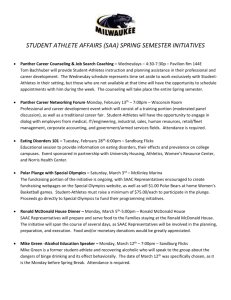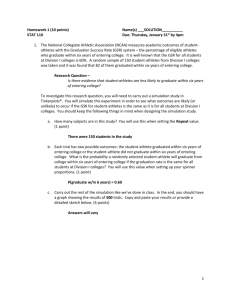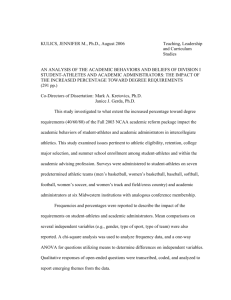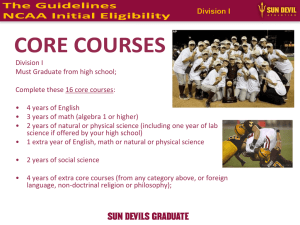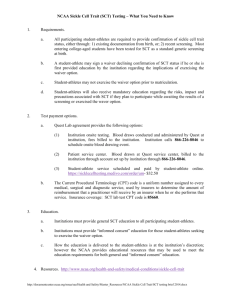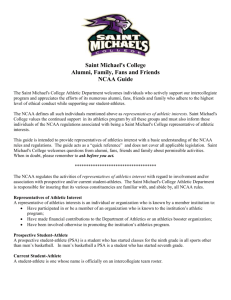Intercollegiate Athletics
advertisement
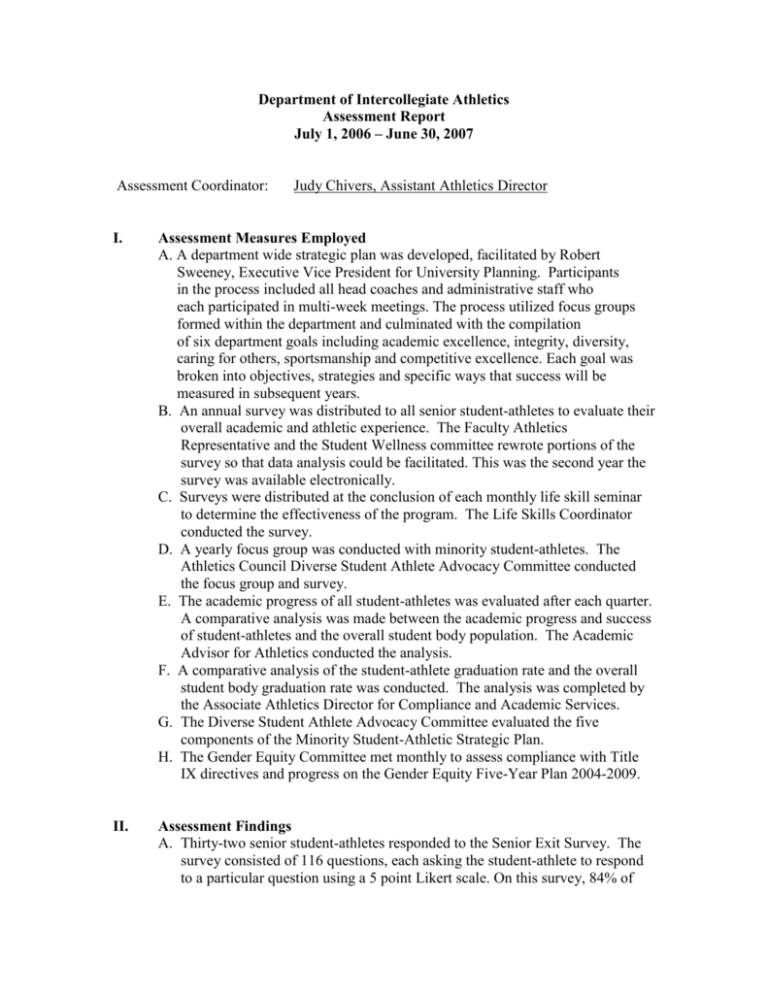
Department of Intercollegiate Athletics Assessment Report July 1, 2006 – June 30, 2007 Assessment Coordinator: Judy Chivers, Assistant Athletics Director I. Assessment Measures Employed A. A department wide strategic plan was developed, facilitated by Robert Sweeney, Executive Vice President for University Planning. Participants in the process included all head coaches and administrative staff who each participated in multi-week meetings. The process utilized focus groups formed within the department and culminated with the compilation of six department goals including academic excellence, integrity, diversity, caring for others, sportsmanship and competitive excellence. Each goal was broken into objectives, strategies and specific ways that success will be measured in subsequent years. B. An annual survey was distributed to all senior student-athletes to evaluate their overall academic and athletic experience. The Faculty Athletics Representative and the Student Wellness committee rewrote portions of the survey so that data analysis could be facilitated. This was the second year the survey was available electronically. C. Surveys were distributed at the conclusion of each monthly life skill seminar to determine the effectiveness of the program. The Life Skills Coordinator conducted the survey. D. A yearly focus group was conducted with minority student-athletes. The Athletics Council Diverse Student Athlete Advocacy Committee conducted the focus group and survey. E. The academic progress of all student-athletes was evaluated after each quarter. A comparative analysis was made between the academic progress and success of student-athletes and the overall student body population. The Academic Advisor for Athletics conducted the analysis. F. A comparative analysis of the student-athlete graduation rate and the overall student body graduation rate was conducted. The analysis was completed by the Associate Athletics Director for Compliance and Academic Services. G. The Diverse Student Athlete Advocacy Committee evaluated the five components of the Minority Student-Athletic Strategic Plan. H. The Gender Equity Committee met monthly to assess compliance with Title IX directives and progress on the Gender Equity Five-Year Plan 2004-2009. II. Assessment Findings A. Thirty-two senior student-athletes responded to the Senior Exit Survey. The survey consisted of 116 questions, each asking the student-athlete to respond to a particular question using a 5 point Likert scale. On this survey, 84% of athletes reported their overall Wright State experience as either good or excellent. Academic and social experiences were overwhelmingly positive. Competitive facilities were rated good or excellent by 75% of the athletes while practice facilities were reported to be good or excellent by 65% and fair by 35%. Overwhelmingly positive responses were given for equipment room support, strength and conditioning support, athletic training room support, and academic support. Scheduling classes around practice some time in their career was problematic for 28% of those surveyed. Academic advising services were rated positively with 90% rating the overall quality of academic services provided by the athletics department as good or excellent, but improvement was suggested in the area of educating athletes on major requirements and keeping the athlete informed of academic progress with 22% suggesting improvement needed. The addition of an additional academic advisor should do much to correct this situation. The survey was improved this year to eliminate the yes/no questions and change all responses to a response on a scale of 1 to 5. This is the second year that the exit interview has been available on-line. Overall experience Facilities and equipment Academic Services Student Services Strength and Conditioning Athletic Training n 32 32 32 32 32 32 mean 3.026 3.033 3.430 3.380 3.492 3.309 standard deviation 0.766 0.846 0.901 1.16 0.960 0.660 B. All student-athletes are required to attend a life skill seminar on the Sunday preceding the beginning of the new academic year. This program is designed to maintain intercollegiate athletics as an integral part of the campus educational program and the student-athlete as an integral part of the student body through educational programs and resources focusing on gender equity, student-athlete welfare, and life skills. Seminars were also given during the year, allowing the student-athlete to choose among different topics and interests. Student-athletes were required to attend one session per quarter. At the conclusion of each seminar the student-athletes completed a qualitative survey that addressed the student-athlete’s opinions of the presentation. The cumulative results revealed that the seminars continue to be well received. Highest rated were those that stressed audience involvement. The surveys from the Raider Skills Day program (e.g. student-athlete convocation) revealed that the student-athletes did enjoy and find helpful the presentation given by the NCAA-approved speaker on diversity, an improvement over last year. The speaker chosen was very audience driven and had the athletes interact and take part in the presentation. C. On January 23, 2007, the Athletics Council Diverse Student-Athlete Advocacy Committee conducted a focus group luncheon for minority student-athletes. The purpose of the luncheon was designed to assist the Diverse Student-Athlete Advocacy Committee in measuring efforts to protect and nurture the welfare and development of diverse student-athletes. The response rate continued to be low this year, in spite of more advance notice. Plans are in place to make this a night event, and move it to late spring when potentially more student-athletes will be able to attend. The luncheon time has been problematic for many, who have tight class schedules during the day to allow for practices in late afternoon. The results from the focus group did not yield any concerns regarding campus and athletics department diversity efforts. This was reiterated on the senior exit interview. D. A comparative analysis between the quarterly and cumulative grade point averages of student-athletes and non student-athletes was conducted. The results of this analysis are located in Table 2. Table 2. Quarter and Cumulative Grade Point Average Fall Quarter 2006 Fall Cumulative Student-Athletes 2.978 3.028 All Students 2.854 2.896 Winter Quarter 2007 Winter Cumulative 3.013 3.046 2.846 2.941 Spring Quarter 2007 Spring Cumulative 2.981 3.038 2.865 2.949 During each academic quarter, the student-athletes performed better than non student-athletes. This affirms that the majority of student-athletes have successfully balanced the demands of being a full-time student and athlete while maintaining satisfactory progress towards their degree. E. The NCAA Official 2007 Division I Graduation Rates Report contains the most recent data. The report examines the graduation rates of the freshmen cohort that entered Wright State University during the 2000-2001 academic year, as well as, the four-class graduation average. The results are reported in Table 3. Table 3. Official 2007 Division I Graduation Rates 2000-01 Graduation Rate Four Class Average Student-Athletes 68% 64% All Students 43% 41% The data indicates that student-athletes are graduating at a higher percentage rate than the overall student body. F. Wright State University reported 6 secondary violations of NCAA rules. This number falls within the acceptable amount of yearly inadvertent violations. G. The Diverse Student Athlete Advocacy Committee evaluated the five components of the Minority Student-Athletic Strategic Plan. The results are reported below: 1. Diverse student-athletes should strive for a graduation rate equal to or higher than the overall student-athlete graduation rate. Data The 2007 NCAA Graduation Rates Report will reflect the following data based on the 2000 cohort of student-athletes at WSU: 31 of 46 (67%) non-minority student-athletes graduated 4 of 5 (80%) diverse student athletes graduated 2 of 2 (100%) non-resident alien (international students) student-athletes graduated Conclusion Wright State University exceeds this recommendation. 2. Diverse student-athletes should strive for a retention rate that is equal to or higher than the overall student-athlete retention rate (this variable looks at scholarship student-athletes only). Data Diverse Student-Athletes not retained: 7 Non-diverse Student-Athletes not retained: 15 Conclusion Wright State University exceeds this recommendation. 3. The level of academic ineligibility for diverse student-athletes should be no higher their proportional representation at Wright State University. Data 2 diverse student-athletes are currently ineligible. 3 non-diverse student-athletes are currently ineligible. Conclusion Wright State University exceeds this recommendation. 4. Diverse student-athletes as a group should strive for a grade point average that is equal to or higher than the overall student-athlete grade point average. Data Overall Student-Athlete GPA Student-Athletes' GPA minus diverse student athletes Diverse Student-Athletes GPA Cumulative Term 3.051 3.016 3.117 3.089 2.771 2.607 Conclusion Wright State University does not meet this recommendation. 5. The Athletics Department will insure that the number of diverse participants in intercollegiate athletics will not fall below the percentage of diverse students at the university. Data Diverse student-athletes constitute 15.9% of the overall athletes. Diverse students constitute 15.7% of the Wright State University student population. Conclusion Wright State University meets this recommendation. Overall, the diverse student-athletes met 4 of the 5 Recommendations. H Gender Equity Committee Assessment: After examining the 2006 Equity Athletics Disclosure Act Report submitted by Wright State Athletics to the NCAA along with various other documents, the committee concluded the following: 1. Wright State Athletics was in compliance with Title IX regarding Accommodation of Athletics Interests and Abilities. 2. Wright State Athletics was in compliance with Title IX regarding scheduling of games and practice times. 3. Wright State Athletics was in compliance with Title IX regarding travel and per diem allowance. 4. Wright State Athletics was in compliance with Title IX regarding tutors for athletes, locker rooms, practice and competitive facilities, housing, and publicity. 5. Wright State Athletics is awarding 5.3% greater financial assistance to female student-athletes. Analysis of actual dollars spent for equipment and supplies, recruiting, and support services showed male athletes receiving greater benefits. Monitoring will continue. III. Program Improvements The following list of program improvements, based on the assessment results, is being implemented during the 2007-08 academic year: 1. The hiring of an additional academic advisor is in the works to ensure adequate monitoring of all sixteen teams. 2. Practice facility issues are continuing to be examined. 3. Rules education continues for student athletes and coaches alike. Student athletes receive rules education at monthly Student Athletic Advisory Council meetings and coaches have monthly compliance meetings as a group and receive updates in monthly newsletters from the Compliance department. 4. The implementation of the comprehensive department strategic plan designed to align all areas within the department to enhance efficiency while improving the overall athletics experience for all student-athletes is underway. Measurable goals have been identified and will be monitored. 5. Exit interviews for seniors are now being conducted quarter by quarter as eligibility expires. This will allow for better return rates and follow-up when issues are identified. IV. Assessment Plan Compliance Improvements in the senior exit interview process continue to be a priority of the Student Wellness Committee. Surveys will now be distributed following the quarter a student-athlete’s eligibility expires starting in Fall 2007 and mid-career interviews will become available on-line in Winter, 2008. The Gender Equity and Diverse Student Athlete Advocacy committees continue to monitor progress in the five year plans. V. New Assessment Developments The department is currently comparing quarter by quarter return rates of Academic progress reports to identify how best to facilitate delivery to the faculty and increase return rates. As the strategic plan is implemented the success of each goal will be measured.
